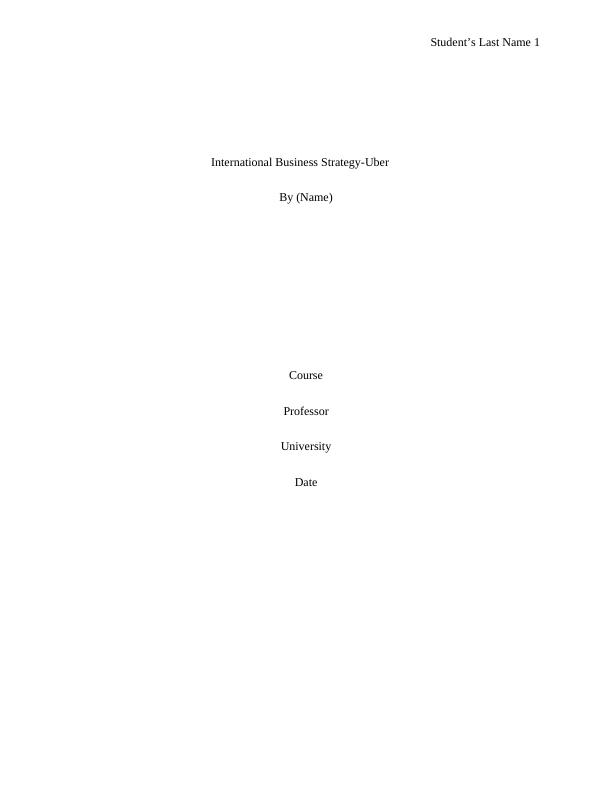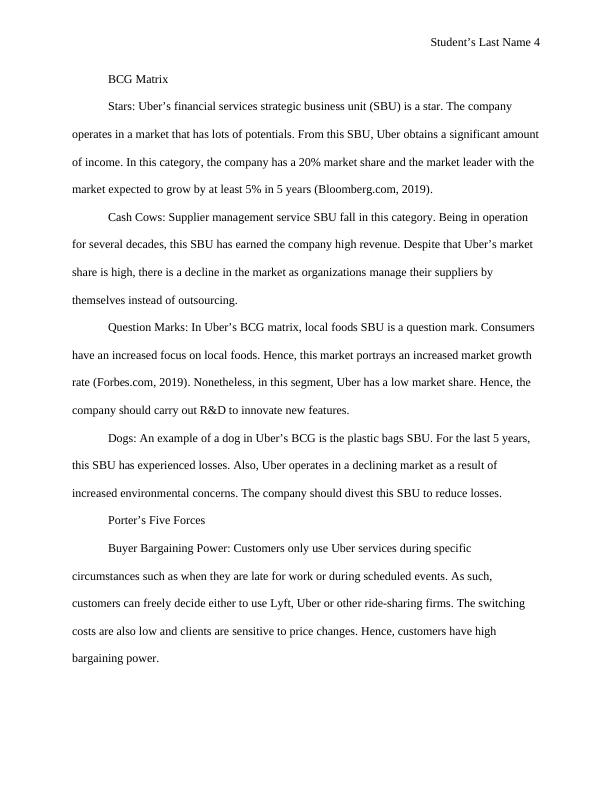International Business Strategy of Uber
Added on 2023-03-23
11 Pages3051 Words66 Views
Student’s Last Name 1
International Business Strategy-Uber
By (Name)
Course
Professor
University
Date
International Business Strategy-Uber
By (Name)
Course
Professor
University
Date

Student’s Last Name 2
Introduction
Uber is a mobile application that aims at connecting drivers to individuals that need a
ride. With certainty, it can be said that the organization has implemented a number of interesting
strategies. The strategies, whether sustainable or not, has assisted Uber to achieve incredible
success. In reality, the organization has successfully enhanced the development of its platform
through reliance on third parties. In addition, Uber has also decided to remain on the hedge,
proclaiming war both to the legislative institutions that are in support of the taxi lobby, including
its competitors who are currently teaming up to hinder Uber’s expansion. Irrespective of Uber’s
many mistakes and not always just conduct, the organization is an attractive option to the
investors, and it has got striking growth potential. In spite of Uber’s potentials, the company still
is required to overcome several challenges: obstacles arising from the market within which it is
competing as well as those challenges that are self-inflicted as a result of the company’s arrogant
strategies. To better understand Uber’s potentials, including the issues that it is likely to face in
the future, it is worth evaluating the company’s strategy.
Question 1
Uber’s International Business Strategy
Increasing the number of services to meet the needs of its customers: Based on the
customers’ budget, occasion as well as the reasons for requesting a ride, clients can choose
among Uber Access, Rush, Pool, X, Go, Premium, XI, Auto, or Access (Newsroom.uber.com,
2019).
Increased consumer convenience: Uber manages to provide unprecedented user
convenience at different levels. Customers do not have to wait in line, call dispatch or wave for a
curb. Rather, customer request for a ride by tapping “request” on their phone and the driver
Introduction
Uber is a mobile application that aims at connecting drivers to individuals that need a
ride. With certainty, it can be said that the organization has implemented a number of interesting
strategies. The strategies, whether sustainable or not, has assisted Uber to achieve incredible
success. In reality, the organization has successfully enhanced the development of its platform
through reliance on third parties. In addition, Uber has also decided to remain on the hedge,
proclaiming war both to the legislative institutions that are in support of the taxi lobby, including
its competitors who are currently teaming up to hinder Uber’s expansion. Irrespective of Uber’s
many mistakes and not always just conduct, the organization is an attractive option to the
investors, and it has got striking growth potential. In spite of Uber’s potentials, the company still
is required to overcome several challenges: obstacles arising from the market within which it is
competing as well as those challenges that are self-inflicted as a result of the company’s arrogant
strategies. To better understand Uber’s potentials, including the issues that it is likely to face in
the future, it is worth evaluating the company’s strategy.
Question 1
Uber’s International Business Strategy
Increasing the number of services to meet the needs of its customers: Based on the
customers’ budget, occasion as well as the reasons for requesting a ride, clients can choose
among Uber Access, Rush, Pool, X, Go, Premium, XI, Auto, or Access (Newsroom.uber.com,
2019).
Increased consumer convenience: Uber manages to provide unprecedented user
convenience at different levels. Customers do not have to wait in line, call dispatch or wave for a
curb. Rather, customer request for a ride by tapping “request” on their phone and the driver

Student’s Last Name 3
arrives within minutes (Cannon and Summers, 2014, pp.27). In addition, with Uber, disputes
resolution is easy.
Saving cost through innovation: Uber is capable of saving costs through innovation
whereby it has an app that integrates innovates features as well as characteristics. Hence, at the
core of the organization’s business strategy is to use innovation to operate at low costs (Smith,
2016, pp.386). Being the first mover in the Internet-based ride-hailing industry provides Uber
with increased competitive advantage.
Expanding to other Markets
Ansoff Matrix
Market penetration: Uber penetrates markets by applying several promotions techniques.
They comprise of distributing promos codes that allow the customers to obtain discounts for their
next ride, including “Uber VIP” loyalty program (Bashir and Verma, 2017, pp.7). Nonetheless,
by inviting friends to sign up and ride with Uber, users earn free rides.
Product development: Uber, an international transportation organization continuously
increases the number of its services. At the moment, its services include Uber X, Go, AUTO,
MOTO, Rush, XI, and Premium among others.
Market development: This is a strategy that involves finding new markets for an existing
product. Uber is operating in over 760 states globally and this global transportation company
intends to engage many more markets (Forbes.com, 2019).
Diversification: It entails developing new products for new markets. Diversification is a
risky strategy (TechCrunch, 2019). Initially, Uber was launched as a taxi organization but has
diversified its operations by entering the food takeaway delivery segment.
arrives within minutes (Cannon and Summers, 2014, pp.27). In addition, with Uber, disputes
resolution is easy.
Saving cost through innovation: Uber is capable of saving costs through innovation
whereby it has an app that integrates innovates features as well as characteristics. Hence, at the
core of the organization’s business strategy is to use innovation to operate at low costs (Smith,
2016, pp.386). Being the first mover in the Internet-based ride-hailing industry provides Uber
with increased competitive advantage.
Expanding to other Markets
Ansoff Matrix
Market penetration: Uber penetrates markets by applying several promotions techniques.
They comprise of distributing promos codes that allow the customers to obtain discounts for their
next ride, including “Uber VIP” loyalty program (Bashir and Verma, 2017, pp.7). Nonetheless,
by inviting friends to sign up and ride with Uber, users earn free rides.
Product development: Uber, an international transportation organization continuously
increases the number of its services. At the moment, its services include Uber X, Go, AUTO,
MOTO, Rush, XI, and Premium among others.
Market development: This is a strategy that involves finding new markets for an existing
product. Uber is operating in over 760 states globally and this global transportation company
intends to engage many more markets (Forbes.com, 2019).
Diversification: It entails developing new products for new markets. Diversification is a
risky strategy (TechCrunch, 2019). Initially, Uber was launched as a taxi organization but has
diversified its operations by entering the food takeaway delivery segment.

Student’s Last Name 4
BCG Matrix
Stars: Uber’s financial services strategic business unit (SBU) is a star. The company
operates in a market that has lots of potentials. From this SBU, Uber obtains a significant amount
of income. In this category, the company has a 20% market share and the market leader with the
market expected to grow by at least 5% in 5 years (Bloomberg.com, 2019).
Cash Cows: Supplier management service SBU fall in this category. Being in operation
for several decades, this SBU has earned the company high revenue. Despite that Uber’s market
share is high, there is a decline in the market as organizations manage their suppliers by
themselves instead of outsourcing.
Question Marks: In Uber’s BCG matrix, local foods SBU is a question mark. Consumers
have an increased focus on local foods. Hence, this market portrays an increased market growth
rate (Forbes.com, 2019). Nonetheless, in this segment, Uber has a low market share. Hence, the
company should carry out R&D to innovate new features.
Dogs: An example of a dog in Uber’s BCG is the plastic bags SBU. For the last 5 years,
this SBU has experienced losses. Also, Uber operates in a declining market as a result of
increased environmental concerns. The company should divest this SBU to reduce losses.
Porter’s Five Forces
Buyer Bargaining Power: Customers only use Uber services during specific
circumstances such as when they are late for work or during scheduled events. As such,
customers can freely decide either to use Lyft, Uber or other ride-sharing firms. The switching
costs are also low and clients are sensitive to price changes. Hence, customers have high
bargaining power.
BCG Matrix
Stars: Uber’s financial services strategic business unit (SBU) is a star. The company
operates in a market that has lots of potentials. From this SBU, Uber obtains a significant amount
of income. In this category, the company has a 20% market share and the market leader with the
market expected to grow by at least 5% in 5 years (Bloomberg.com, 2019).
Cash Cows: Supplier management service SBU fall in this category. Being in operation
for several decades, this SBU has earned the company high revenue. Despite that Uber’s market
share is high, there is a decline in the market as organizations manage their suppliers by
themselves instead of outsourcing.
Question Marks: In Uber’s BCG matrix, local foods SBU is a question mark. Consumers
have an increased focus on local foods. Hence, this market portrays an increased market growth
rate (Forbes.com, 2019). Nonetheless, in this segment, Uber has a low market share. Hence, the
company should carry out R&D to innovate new features.
Dogs: An example of a dog in Uber’s BCG is the plastic bags SBU. For the last 5 years,
this SBU has experienced losses. Also, Uber operates in a declining market as a result of
increased environmental concerns. The company should divest this SBU to reduce losses.
Porter’s Five Forces
Buyer Bargaining Power: Customers only use Uber services during specific
circumstances such as when they are late for work or during scheduled events. As such,
customers can freely decide either to use Lyft, Uber or other ride-sharing firms. The switching
costs are also low and clients are sensitive to price changes. Hence, customers have high
bargaining power.

End of preview
Want to access all the pages? Upload your documents or become a member.
Related Documents
Uber: A Market Analysis and Recommendations for the Futurelg...
|13
|1284
|173
Business Organisations and Management Assignment (Doc)lg...
|5
|935
|93
UBER: Marketing Mix, Differentiation, and Competitive Advantagelg...
|18
|5854
|382
Uber Case Analysislg...
|11
|2271
|372
(PDF) The Evolution of Urban Transportlg...
|9
|2754
|38
Marketing Strategies of Uber Poollg...
|7
|1078
|268
